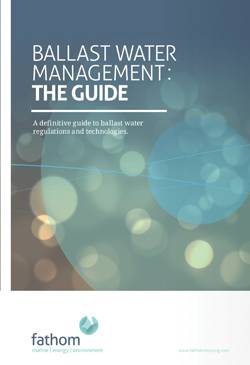Many of the challenges related to engineering the actual installation of a ballast water treatment system have been noted in the sections describing the treatment technology factors above. These challenges can be especially acute when installing a system on an existing vessel.
Finding solutions to treatment system back pressure and potential f low rate reductions, power consumption demands, control system integration and space requirements, as well as access for installation, can be difficult and costly. While these are worked out with the vendor, design engineer and class society, the following additional factors should also be taken into consideration.
Intake/Discharge Isolation: Cross-Contamination
Care must be taken when designing the piping system modification required for treatment system installation to prevent any accidental cross-contamination of intake and discharge water – a particular concern for systems that redirect the main ballast f low.
Cross-contamination can occur if contaminated water, either from the sea chest or a tank which may require treatment prior to discharge, passes through a pipe that is shared by the treated ballast water being discharged. Valves which do not provide a reliable seal may also allow some contamination of treated ballast.
Isolation of intake and discharge flows is not always possible.
However, in two-pump ballast systems where flexibility in the ballasting/deballasting time is acceptable, it is recommended that one pump be dedicated for ballast intake and one for discharge. Transfers between tanks should be done by the ‘discharge’ or ‘clean’ pump unless
Sampling and In-Service Testing
Designing proper and convenient sampling and testing facilities is an important part of the installation engineering. Port State Control and other authorized regulatory officers may, at any time for the purpose of determining whether the ship is in compliance with the discharge requirements, come on board and take samples of the ballast water. IMO G2 ‘Guidelines for Ballast Water Sampling’ call for the sampling to be a simple and speedy process, applicable at the point of ballast discharge and safe to the ship and crew.
The sample volume and method for biota collection are key to the design of the sampling facilities which should include flexible hoses, holding tanks and work area. Unfortunately, with the sampling port required to be near the discharge that is often located in the engine room where space is limited, handling of significant quantities of water may be difficult to arrange or simply impractical.
Maintaining Ballasting Flexibility
Full ballast system operational flexibility can be maintained with treatment systems. However, it may not be necessary or cost effective for particular ships to provide for the treatment of all isolated ballast systems on board, maintain maximum flow rates at all times and provide for stripping systems (eductors) to continue to be used.
Examples
1. A vessel that does not move significant ballast during normal operations may not need the treatment system to handle full pumping f low rates.
2. Eductor-based stripping systems may not need special attention if the full treatment course is completed in the tank before discharge, or if the eductor power water can be taken from a treated source.
3. Dedicating ballast pumps for intake and discharge may reduce f flexibility but may simplify piping connections and lower the risk of cross-contamination.
Maintaining Ballasting Flexibility
While for most existing vessels, detailed as-built drawings of the ship’s ballast piping system and engine room arrangement may not be readily available, gathering of certain relevant information is important to a smooth installation (as well as possible treatment selection decisions) and should not be overlooked. Detailed dimensional information is required for all vessel systems and outfits that may be impacted by the new equipment in order to properly evaluate locations for equipment installation and piping runs and avoid interferences.
Further, installation sequence planning requires a detailed understanding of routes for equipment access and the minimum clearances available. Availability of suitable equipment lifting points also needs to be documented. Advanced techniques using 3-D laser scanning technology may be useful in this regard.
Sediment Control
Ballast water tanks and their internal structure should be designed to minimize accumulation of sediments and permit for easy cleaning and maintenance. Design guidance of ballast tanks and other design enhancements given in the G12 Guidelines are to be adhered to as far as practicable. There are also practical steps or procedures that can be implemented in the ballast water operation for sediment control. The recommendations given in the G4 Guidelines, Part A, Section 1.3, are to be adhered to as far as practicable.
Details of the methods and operational procedures for the sediment management on board the vessel, including the disposal of sediments and the associated safety considerations, etc., are to be documented in the vessel’s ballast water management plan (BWMP).
The remainder of Chapter 5 sets out the installation criteria that must be met in order for a ship to gain the optional BWT or BWT+ notation from class society ABS. These are included to demonstrate the range of technological factors that operators must consider.
‘Ballast Water: The Guide’ is available to pre-order at www.fathomshipping.com/Guides and Amazon priced at £95 from December 12th. Email: [email protected]














